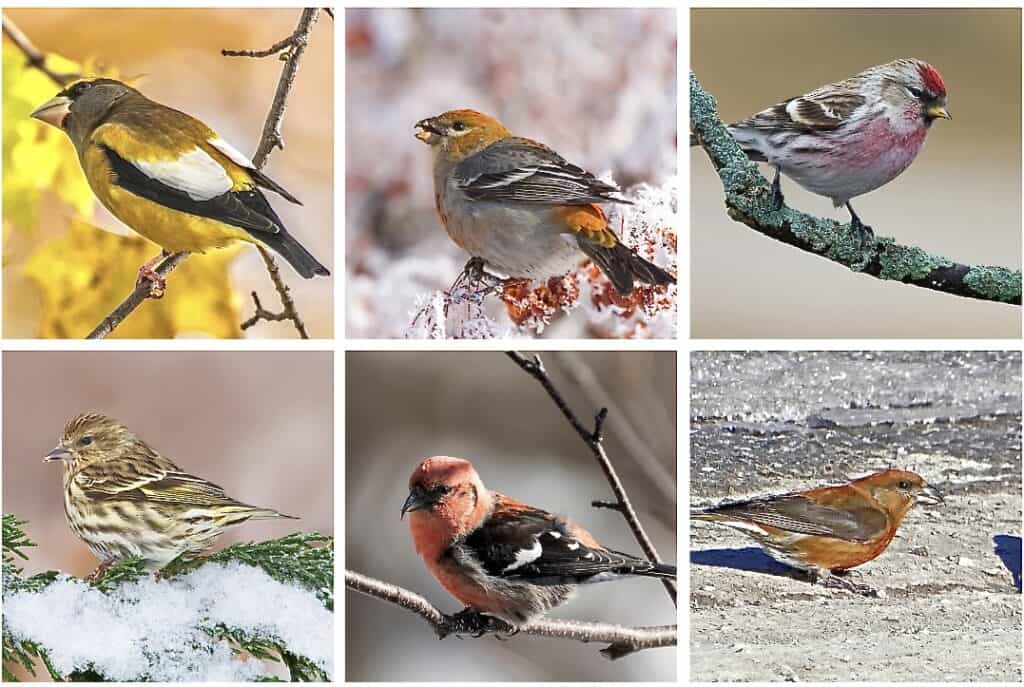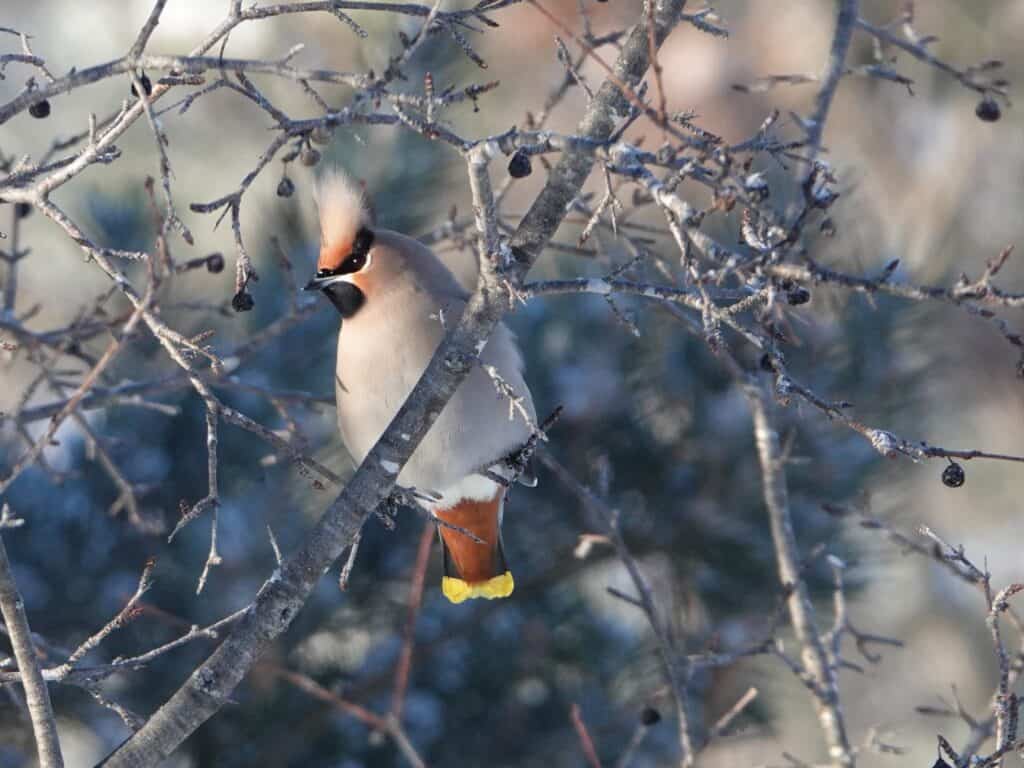All eight winter finch species could turn up in the Kawarthas this fall and winter
Peterborough Examiner – October 27, 2023 – by Drew Monkman
It’s hard not to love winter finches. Their mysterious, nomadic nature and colourful plumage makes them a favourite of bird lovers everywhere. And, you never really know with certainty what species might turn up at your feeders or at your crab-apple tree. But be prepared. Late fall and winter this year could see the arrival of all eight winter finch species: evening grosbeak, pine grosbeak, common redpoll, hoary redpoll, pine siskin, purple finch, white-winged crossbill and red crossbill.
Some winters many of these birds are totally absent, while other years they can empty feeders in less than a day. But why do finch numbers fluctuate so widely from one year to the next? Although not entirely understand, a big part of the answer lies in the status of the wild food crop in the boreal forest. Winter finches move southward – or east or west – when there is a shortage of food in their boreal breeding territories of northern Ontario and Quebec. The wild foods they depend upon most are the seeds and berries of trees such as birches, alders, American mountain-ashes, pines, tamaracks, and spruces.
Many factors affect seed and berry abundance from one year to the next, including severe late spring frosts, too much or too little precipitation, insect pressures, and disease. Other poorly understood reasons appear to be at play, as well. The end result is that seed production can be reduced or completely aborted over hundreds of kilometres.
As long as seed crops are good in the north, the birds stay put. When food is lacking, they will sometimes fly thousands of kilometres to find it. In the fall of 2020, birders observed over a thousand evening grosbeaks in a single day flying past Hawk Cliff on the north shore of Lake Erie. Later, in the winter of 2021, grosbeaks turned up as far south as Florida.

Winter Finch Forecast
From 1999 to 2019, Ron Pittaway of the Ontario Field Ornithologists prepared an annual Winter Finch Forecast of what species to expect in the coming fall and winter. The publication of the forecast has become one of the most highly anticipated events in the North American birding community. Four years ago, Tyler Hoar of Oshawa took over forecasting duties. Sadly, his mentor, Ron Pittaway, passed away this summer.
Much of the annual data on seed and fruit abundance in the boreal forest comes from Ministry of Natural Resources and Forests staff, foresters and volunteer naturalists. This year, observers in the north have noted a poor cone crop on spruce but lots of seeds on alders and abundant berries on American mountain-ash. According to Hoar, this should result in a mosaic of finch movements differing in intensity and timing. All eight species could be on the move. One factor that may entice some to spend time in the Kawarthas is the abundance of cones on our local white pines, eastern white cedars and at least on some spruce.
Individual forecasts
1. Pine siskins: Given the poor white spruce crop, significant numbers of siskins started to leave the boreal forest in mid-September, with 1000s reported daily at migration monitoring stations such as Tadoussac, Quebec. There should therefore be a moderate to possibly strong flight of siskins southward this fall into our area. Already, local birders are reporting siskin sightings almost daily. This entertaining species prefers Nyjerseeds in silo feeders.Watch for them, too, feeding on the seeds of eastern white cedars.
2. Common and hoary redpolls: Redpolls feed largely on the seeds of alder, birch and spruce. Across the boreal forest, only alders a showing a good crop. We can therefore expect a moderate flight south into the Kawarthas. On October 17, more than 2,000 common redpolls were tallied in 60 minutes flying through Tadoussac. Watch for redpolls on birches, in weedy fields and at bird feeders offering Nyjer and black oil sunflower seeds. If a flock graces your backyard, look carefully for small numbers of hoary redpolls, as well. They tend to be larger, paler, and smaller-billed than common redpolls.
3. Purple finch: Although mountain-ash berries are abundant in the boreal forest, Hoar still believes that good numbers of purple finches will overwinter in southern Canada and hopefully in the Kawarthas. An easy way to tell purple finches from look-alike house finches is by checking the tip of the tail: notched (purple finch) or squared-off (house finch). Both species prefer black oil sunflower seeds at feeders.
4. Pine grosbeak: Thanks to the good crop of mountain-ash berries, pine grosbeaks are likely to remain in the boreal forest. Like purple finches, however, some flocks are still expected to turn up in central Ontario. Flocks of hungry grosbeaks search for the seeds of Manitoba maple and for crab-apples. They occasionally show up at platform feeders offering black oil sunflower seeds.
5. Evening grosbeak: Once again, the above-average berry crop in the north will keep most evening grosbeaks at home this winter. However, given a growing population linked to increased outbreaks of spruce budworm – a favourite food source – some birds should descend south into Algonquin Park and maybe the Kawarthas. This species was one of my “spark birds” as a kid. In other words, it helped spark my interest in birding in the 1960s when huge flocks turned up at our backyard feeder. Some people describe them as the Incredible Hunk version of American goldfinches, given their similar colours but bigger size, ferocious eyes and outrageously large beaks. Grosbeaks prefer black oil sunflower seeds, especially when made available on large platform feeders. They also dine on the seeds of Manitoba maples and ashes.
6. Crossbills: Thanks to the crossed tips of the upper and lower mandibles of their bill, crossbills specialize in removing seeds from beneath the scales of conifer cones. The way they contort their bodies – sometimes completely upside down – to extract the seeds is almost parrot-like. Crossbills are mostly attracted to spruce and tamarack, but red crossbills will also visit pines.
Given the poor spruce in the north, it’s expected that small flocks of white-winged crossbills will come south into our area this fall and winter. A flock was seen over Peterborough earlier this week. Red crossbills, too, are a likely bet, thanks in part to the bumper cone crop on white pines.
Red crossbill call types
Red crossbills are the focus of study by ornithologists interested in bird classification. Researchers have noted that crossbill flight calls (jip-jip-jip) vary slightly from place to place throughout North America. Differences in bill and body size also appear to correlate with the ten different types of flight calls. In fact, each call type may represent a different incipient species, somewhat akin to Darwin’s finches.
If you encounter a noisy flock of red crossbills, try to make a recording with your smartphone. Matt Young of the Finch Research Network (info@finchnetwork.org) will identify the call type if you email him your recordings or if you upload them to an eBird checklist.
One more bird to watch for – albeit not a finch – is the bohemian waxwing. Although the mountain-ash berries will likely keep most bohemians in the north, some flocks appear in the Kawarthas almost every winter. When they show up, these regal birds feed heavily on the fruit of European buckthorn, European mountain-ash, and ornamental crab-apples.
You can follow finch wanderings this fall and winter on eBird, on the Finch Research Network website at https://finchnetwork.org/, and on the Finches, Irruptions and Mast Crops Facebook group. You might also consider driving up to Algonquin Park. Only two-and-a-half hours from Peterborough, it’s one of the best places to see winter finches in all of central Ontario. The feeders at the visitor centre are always busy and convenient to watch from the viewing deck. The nearby Spruce Bog Trail can also be very productive for finches, along with Canada jays and even boreal chickadees. Before heading up, check Nipissing County on eBird to see what species are being reported in the park.
